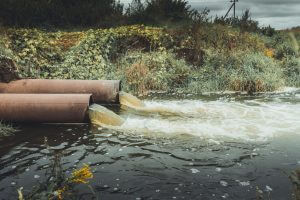Improving Sewage Treatment

Combined sewage overflow pipes
Although sewage treatment has improved vastly since the passage of the Clean Water Act, after more than four decades of permitting treatment and discharge of sewage, communities across the country still dump pollutants into the nation’s waters that are harmful to fish and wildlife and humans. Everyone agrees that there has been significant improvement in the treatment of sewage, but billions of gallons of raw or partially treated sewage still make it to our waters every year through combined sewer overflows (systems designed to treat sewage and stormwater together), leaking pipes, and permitted “bypass.” Challenges to reducing sewage pollution and making improvements include:
- New chemical threats – new chemicals are approved every day and wastewater treatment plants do not remove all chemicals from sewage. For example, there are concerns about pharmaceuticals, microbeads, caffeine and many toxic contaminants that are not removed during the treatment process.
- Crumbling infrastructure and underinvestment – Federal investment in sewage treatment started as grants and then transitioned to the state revolving fund loans that have invested billions in improvements. Despite this, overall investment has not kept up with aging infrastructure, now taxed by sprawling development and climate change, leading to a spending gap of over $100 billion over a 20 year period.
Learn more about State Revolving Funds in River Network’s Equitable Infrastructure Toolkit.
- Failure to control nutrients – treatment standards for sewage treatment plants typically do not require control of excess nutrients such as phosphorus and nitrogen as part of permit limits.
- Permit limits may not be protective of the environment – Even with standards and permits in place, permit limits and conditions are often not protective enough and many sewage treatment plants are not in compliance with their permits, and some permits allow bypass of treatment facilities.
New strategies are being developed to address some of these problems. Many communities are looking to decentralize their treatment systems as a way to improve efficiency, keep water local, and cut costs. With a heightened attention to the energy demands of transporting and treating sewage, communities have found ways to generate, use and sell energy during the treatment process. And, in spite of the lack of widespread nutrient standards and permit limits for sewage treatment, recognition of the sector’s contribution to excessive nutrient levels and the resultant “dead zones” has led to improvements in the reduction of nutrients in the sewage treatment process.
For the most recent River Network expertise on this type of pollution, check out the webinar recording below:
Learn More
- Combined Sewer Overflows Monitoring by River Network
- The Clean Water Act Owner’s Manual by River Network
- Permitting of sewage treatment plants by U.S. EPA
- The Road Toward Smarter Nutrient Management in Municipal Water Treatment by The Johnson Foundation
- Decentralized Wastewater Systems by Water Environment Research Foundation
- Energy Efficiency Opportunities in Municipal Water and Wastewater Treatment Facilities by American Council for an Energy Efficient Economy
- Energy self sufficiency for wastewater treatment plants by Water Environment Research Foundation
- Case Studies on Implementing Low-Cost modification to Improve Nutrient Reduction at Wastewater Treatment Plants by U.S. EPA
- Smart Sewering by Charles River Watershed Association




